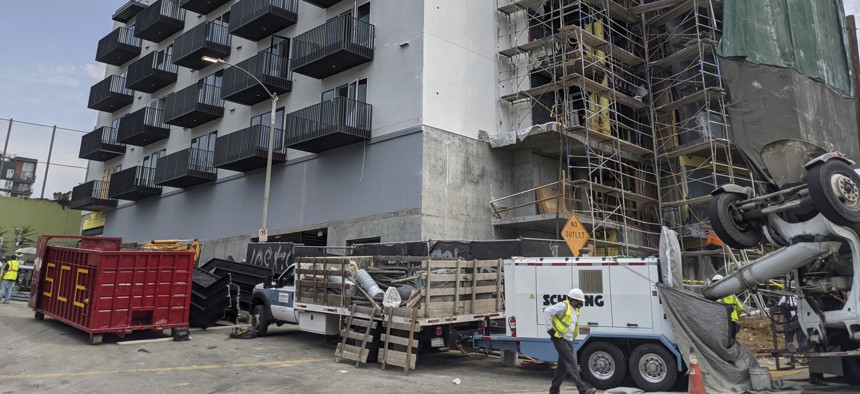Biden Administration Asks Local Governments to Set Housing Goals

In this June 18, 2021, photo, construction workers finish the exterior of an apartment building downtown Los Angeles. AP Photo/Damian Dovarganes
HUD's new ‘House America’ initiative aims to increase the number of affordable housing units and to reduce the number of unhoused people across the country.
The U.S. Department of Housing and Urban Development is launching a new initiative to reduce homelessness by getting local government commitments to build affordable units and reduce the number of people living on the streets.
Housing Secretary Marcia Fudge introduced the “House America” program during a press conference on Monday, calling it “an all hands on deck effort to address our homelessness crisis.”
The plan requires local government leaders to publicly set goals for reducing homelessness. The goals should detail how many homeless people the localities plan to rehouse and how many new units of affordable housing they intend to build by the end of 2022.
White House officials said the initiative is meant to help ensure that local governments are aware of billions of dollars worth of programs funded through the CARES Act and American Rescue Plan Act that can be tapped for housing support.
“You have an historic amount of resources in different programs,” Gene Sperling, a special advisor to President Biden who is coordinating ARPA programs for the White House, said as he spoke during Monday’s announcement. “Within the rescue plan there is a lot of money that could help supplement your efforts.”
A recent guide published by HUD details numerous ARPA-funded programs that can be used on housing initiatives. They include $5 billion for emergency housing vouchers, $46 billion in emergency rental assistance, and $5 billion in HOME investment partnerships that can be used for rental assistance and supportive services as well as for production or preservation of affordable housing.
State and local governments can also use their allotments of $350 billion in direct aid through ARPA for housing initiatives. It’s a pool of money that not enough local governments are using to address homelessness, Sperling said.
“I encourage people to think broadly—think of what can be done if you consolidate these types of funding sources,” he said.
Twenty-five city, county, tribal, and state leaders have already signed onto the HUD initiative. The department will support participants by providing technical assistance, data support, and communication and other tools to help them meet their housing goals.
Several participants spoke at Monday’s press conference to discuss local housing goals and how they intend to meet them.
Philadelphia Mayor Jim Kenney said the city aims to rehouse 3,000 homeless individuals or families. Through ARPA, the city was granted 863 emergency housing vouchers that can be used to meet that goal. In addition, the city is spending to rehab older houses where homeless individuals will be able to live together as roommates. To increase the number of landlords that accept housing vouchers, Kenney said the city has also created a program that helps smaller landlords make repairs to their buildings so that they can meet the standards required to participate in the housing voucher program.
Overall, ARPA will provide funding for approximately 70,000 emergency housing vouchers, Fudge said.
Homelessness was already a major focus for government officials in Mesa, Arizona before the pandemic, said Mayor John Giles. But the price of a single family home has risen 29% during the pandemic and rental costs are similarly soaring—meaning investments in affordable housing are needed more than ever, Giles said.
Through the federal initiative, cities and counties in the Maricopa County region, where Mesa is located, are working together to address homelessness and set a regional goal of creating 1,225 new units of affordable housing, Giles added. That investment would “solve 25% of our region’s demand,” he said.
Andrea Noble is a staff correspondent with Route Fifty.
NEXT STORY: San Diego steps up cloud, remote support, IT service management





